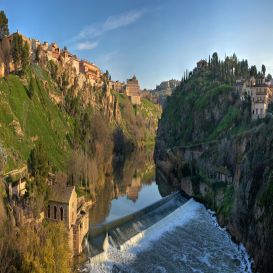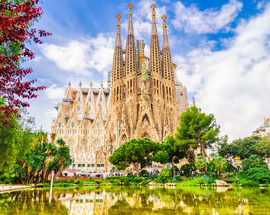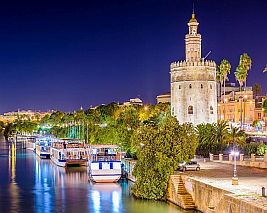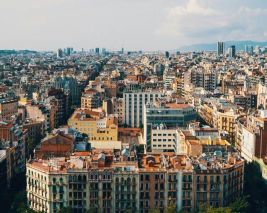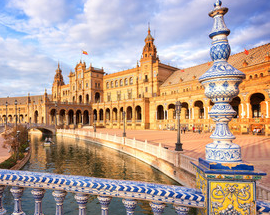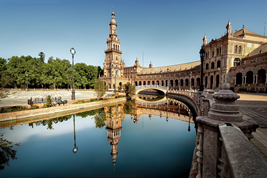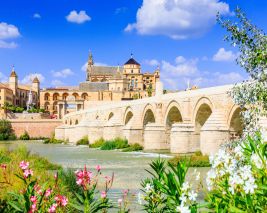Spain is a larger than life expression of beauty. A contrast of wild and tame, layered and exotic, and certainly one of the places that you must visit at least once in your lifetime. It wouldn’t be too off the mark to think of Spain as a symbol of life, vibrant and resonating with culture and all sorts of delights. Travellers to Spain are taken in by the gorgeous vistas, the glorious mountain ranges, the warm Mediterranean waters, the historical cathedrals and of course, the delicious food.
Just a couple of years ago, Spain was one of the second most visited countries in the world, seeing the arrival of as many as 82 million tourists. There’s much to see here, from the scenic coastlines, interesting landscapes to the rich culture, and it’s no wonder then that tourists want to come here, again and again.
Geography Of Spain
As Europe’s 4th largest country, Spain has a diverse landscape with several islands and mountains. Surrounded by Gibraltar, Portugal, Morocco and France, it is bound by the Pyrenees mountain range and the Portugal-Spain border is as long as 1214 km, the longest uninterrupted border in the European Union.
Climate of Spain
Spain has three main kinds of climatic zones – Mediterranean climate with warm and dry summers, semi-arid climate which is desert like and oceanic which has winters and summers that are influenced by the ocean. There are also other climates such as alpine, humid subtropical and tropical in some areas. The variety of different climates makes it an interesting choice for tourists planning to visit Spain at different times of the year. The best time to visit Spain is in the high season, from June to August, although this is also the low season in some parts of inland Spain. The low season is from November to February when central Spain is cold and there’s rain in the north. However, it is high season in ski resorts and the coasts see mild temperatures.
Spanish Culture
Spain’s rich culture is a huge draw for tourism. Going all the way back to the Middle Ages, Spain’s past has a way of interjecting itself into the present through its numerous monuments and cathedrals. Spain’s long and vivid history has been coloured by various struggles and wars and the resultant country today is much like a detailed mosaic of all the various bits and pieces of its past. From its iconic architecture, palaces and charming cobbled streets, Spain’s cities have a life of their own, while the people are warm and welcoming and make every trip to this European country memorable.
Spanish Cuisine
Spain is a mecca for gourmands, a place where good food and wine are never too far away. Spanish cuisine is fresh, local and is a veritable treasure trove of traditional recipes that have been cooked with love and care. The Spanish take their food seriously and you’ll be surprised at the variety of food that you can get there. While you may already be familiar with Spanish cuisine like tapas or paella, imagine getting to eat it all at the source! From jamon to churros to the famed Spanish wine, cuisine forms an integral part of Spanish tourism and rightly so.
Spain Tourism
One of the most visited countries in Europe, Spain has several tourist attractions spread across its many cities. From beaches to mountains to historic monuments to churches and palaces, Spain has it all. Visitors from all over the world come here to not just enjoy these wonderful sights but also various activities such as hiking, skiing, water sports, river-rafting and various forms of water sports. Spain has excellent walking trails that cross the entire country and thanks to the differing climatic conditions that prevail here, it’s possible to visit throughout the year.
Spain’s capital Madrid is a great point to begin your tour. Art galleries that hold national treasures such as Picasso’s Guernica to the Royal Palace which is touted to be the largest palace in Europe, Madrid’s many delights include churches, cathedrals and tapas bars, all intermingling and co-existing in peace.
Barcelona, another famed Spanish city brings a fabulous Mediterranean location, sparkling blue waters, famed museums and the well-known Tibidabo Amusement Park that was opened in 1905. To reach here, you would have to go up Mount Tibidado that is also an excellent vantage point to see the city beyond. The mountain is also famed for its hiking and cycling trails.
Yet another famous Spanish tourism spot is Granada. The ancient fortress surrounded by cobbled streets and snowy peaks in the distance makes for an excellent tourist attraction. People come here to see the glorious Islamic art and architecture that has been preserved carefully through the centuries.
If food is your weakness then don’t miss out on visiting San Sebastian on the Basque Country coast which has numerous bars and tapas restaurants where you can indulge all you want in your love of food. The Concha Beach is beautiful and perfect for families while surfers can head to the not too far Zurriola Beach and enjoy the great waves. For the best paella, head straight to Valencia, often known as the home of the toothsome rice dish. Valencia has gardens, parks, beaches, a cathedral, the majestic Torres de Serranos, if you’re looking for something more than just culinary delights.
Spain is also famous for its flamenco dances and exotic folk music and tourists can’t stay away from Seville, in Andalusia in southern Spain, which has flamenco bars for people to sit back and enjoy this passionate dance. Other places to see in Seville include the Alcazar, the gorgeous royal palace which has been around since before the 12th century. Built by Moorish rulers, this was reclaimed by Catholic kings later on and there has been a unique conglomeration of Islamic and Romanesque architecture that is visible here in the palace.
Tenerife is yet another famed Spanish tourism spot with its volcanic peaks, craters and lava flows. Here, you can find Mount Teide, Spain’s highest peak which is inside the Teide National Park and you can explore several geological wonders here. For those who want a coastal holiday, then Alicante is a great spot too. Popular among tourists, the beach has a Mount Benacantil as its backdrop with Santa Barbara Castle at its summit.
For those fond of architecture, Cordoba offers several interesting insights. The famous Grand Mosque of Cordoba is a UNESCO World Heritage site and has numerous fascinating things to see such as the Roman bridge. Other places to see in Spain include the lush and green Galicia which bashes the myth that Spain only has beaches or dry landscapes. The Pyrenees are also excellent for skiing and are far more economical than resorts you might find in the Alps. Another place to visit could be Almeria, which is the only desert region you can find in Europe while Ronda, a mountaintop village near Malaga is famous for the Puente Nuevo, a stone bridge across the El Tajo gorge. Wine lovers should head straight to La Rioja with its vineyards, wine tours and tastings and every minute of the trip will certainly feel accomplished.
Lastly, Ibiza may have become popular because of its partying and club culture but there’s more to it as you will see when you come across the quiet and peaceful fishing villages and beaches. This makes it an excellent destination for yoga and relaxation.
Spain tourism has much to offer – whether you’re looking for the tried and tested or the offbeat destinations and a visit here will prompt you into booking the next visit. And the next.
Do’s and Don’ts
Do’s
Learn a few words of Spanish as English may not be spoken everywhere and you don’t want to be stuck in any situation where you’re unable to communicate.
- Carry a Spanish phrasebook with you.
- Do take ear plugs as nights in Spain can tend to be quite noisy.
- Enjoy your meals and try to ask for local specialities.
- Make sure you have travel insurance.
Don’ts
- Choose scenic backroads to travel instead of regular motorways. You will enjoy the country far more.
- Don’t worry about the loud conversations taking place around you. You will get used to it soon! If not, make sure you use your earplugs.
- Don’t try to take in everything in one trip. It’s not possible. Do research which places interest you most and which festivals you’d like to visit.

















